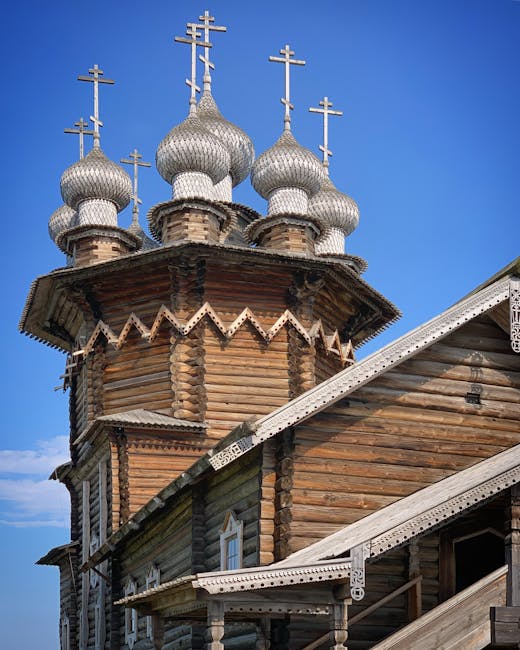
Within the dense canopy of the Congo Basin Rainforest, the afternoon light began to fade, glinting off a soaring metal tower that rose steeply out of the jungle. Measuring 180 feet tall, the narrow steel structure resembled a massive cellular-network antenna, although it was outfitted with a collection of far more critical scientific sensors. The wind had picked up, causing the spire to sway and whine with each strong gust. But a biologist named Fabrice Kimbesa appeared undaunted. After strapping into a safety harness, he grabbed hold of a thin metal ladder and clambered briskly upward, leaving me to catch up as he raced toward a small platform at the very top.
This particular structure is what’s known as an eddy covariance flux tower. When it came online in October 2020, it became the first ever to be located in the Congo Basin. For climate researchers who track greenhouse gas exchanges between the forest and the atmosphere, such spires essentially act like enormous stethoscopes. They’re capable of tracking how much carbon dioxide is released and taken up by the forest to help calculate the world’s emissions being sequestered back into the earth, among many other factors. And so, every day, Kimbesa makes the nerve-racking climb to check the equipment’s readings, monitoring with precision how the forest breathes around him. “When you look at the data … you get the sense that you now have a special connection with the forest,” he says. “You can see things others don’t.”
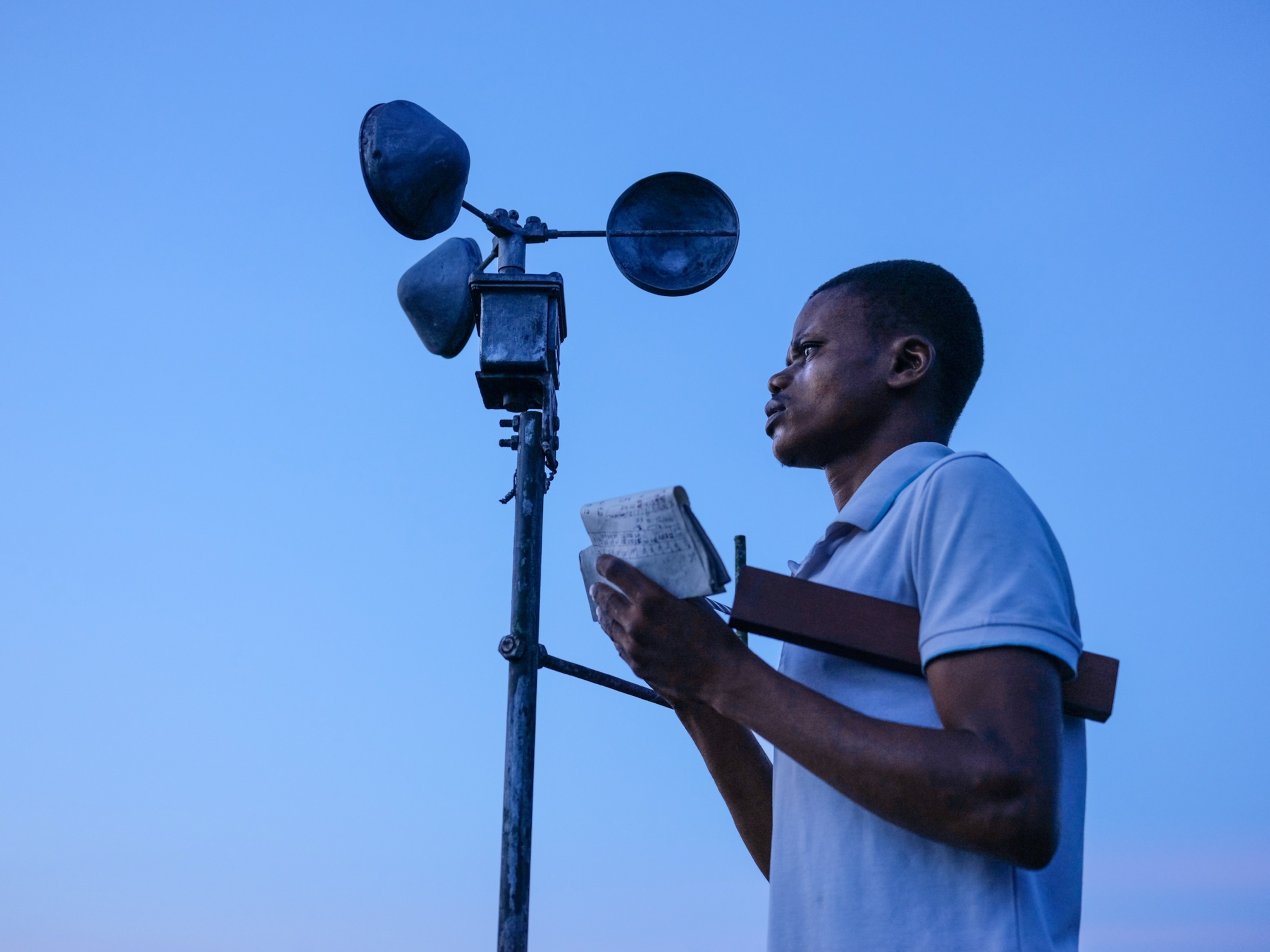
Michel Atianga Bongombe is one of the local observers who monitor climate data at the Democratic Republic of the Congo’s (DRC) Yangambi research station.
Today, after hours of baking beneath the hot equatorial sun, the rainforest seems to be exhaling, its canopy engulfed in clouds of mist. The recorded data showed a more specific trend: Over the past 24 hours, carbon dioxide levels in the area dropped substantially during the day, as trees and other plants converted the greenhouse gas to oxygen during photosynthesis, only to creep back up after sunset.
This kind of work has never been more vital. Tropical forests were once responsible for sequestering roughly half of Earth’s carbon stored on land, but their overall efficacy is declining since a peak in the 1990s. The Congo Basin encompasses the world’s second largest rainforest, behind the Amazon, spanning about 500 million acres across Central Africa. Yet while more than a thousand flux towers have been collecting data about gas exchange rates around the globe for decades, this region had been a blank spot until 2020.
(Polluters are using forests as ‘carbon offsets.’ Climate change has other plans.)
Several years ago, an international consortium of researchers revealed that based on a sample of tropical old-growth forest plots across the Congo Basin, the rainforest appears to be storing carbon at a steadier rate than the Amazon, where the absorption rate has rapidly diminished. But the researchers also noted that since 2010, the African rainforest has seemed to be following a downward path similar to its South American counterpart’s. To figure out what is really happening—and perhaps offer some solutions—Kimbesa and a cohort of newly trained Congolese scientists now operate out of a revitalized research station within the Yangambi Biosphere Reserve, a 900-square-mile protected area in the Democratic Republic of the Congo (DRC).

At the Yangambi station, shown here in 1947, Belgian colonists employed Congolese workers as assistants but didn’t formally train them as scientists.
INERA LIBRARY COLLECTION
The idea that Kimbesa, who recently graduated from the nearby University of Kisangani, might be an important contributor to this research once seemed inconceivable. The DRC, where more than half of the Congo Basin rainforest lies, still suffers from deep poverty and a history of colonial exploitation, dictatorship, and conflicts that have both held back the development of a solid university system and restricted employment and resources for local scientists.

Inspiring exploration for over 130 years
Subscribe now a get a free tote
But as the ecological significance of the region has become more apparent, it has drawn increased attention from global conservation groups such as the Center for International Forestry Research, which has teamed with governments and universities to invest millions in infrastructure, technology, and training of researchers. Since 2005, the number of postgraduates in forestry has grown from just six to more than 300. Today this new vanguard of Congolese scientists is striving to understand one of the most massive and understudied ecosystems on our planet, at a time when it’s needed most.

Scientists are exploring the complicated consequences of transforming peatlands and forest into farmland, like this rice field. The process does release stored carbon, but it can also help sequester it through regeneration.
Scattered across some 60,000 acres, Yangambi’s dilapidated colonial facilities remain a testament to the research station’s tainted origins. The nearest major city is Kisangani, about 70 miles away, which is where Belgium’s King Leopold II in 1885 founded one of the first settlements of what would become his own private colony, the Congo Free State, after his government refused to sanction a state-backed expansion into the territory. The king’s emissaries arrived to discover the rainforest’s vast troves of rubber vines, which could be tapped for latex to fuel the global rubber boom.
To harvest ever more latex, however, the nascent colony required a workforce, and Leopold’s officials contracted with private companies that enslaved Indigenous people in vast numbers. An estimated 10 million people were killed as a result of famine, disease, and the colonizers’ brutality. The government of Belgium had wrested control away from Leopold by 1908 and established the Belgian Congo. During its rule, the new government created the National Institute for Agronomic Study of the Belgian Congo at Yangambi to explore the rainforest and figure out what other crops could be successfully cultivated there. Colonial Belgian researchers collected and analyzed tens of thousands of plant specimens and stored them at Yangambi, where they are still housed today.

People navigate by small paraffin lights in Kinshasa, the DRC’s capital, where less than half the population has access to electricity.
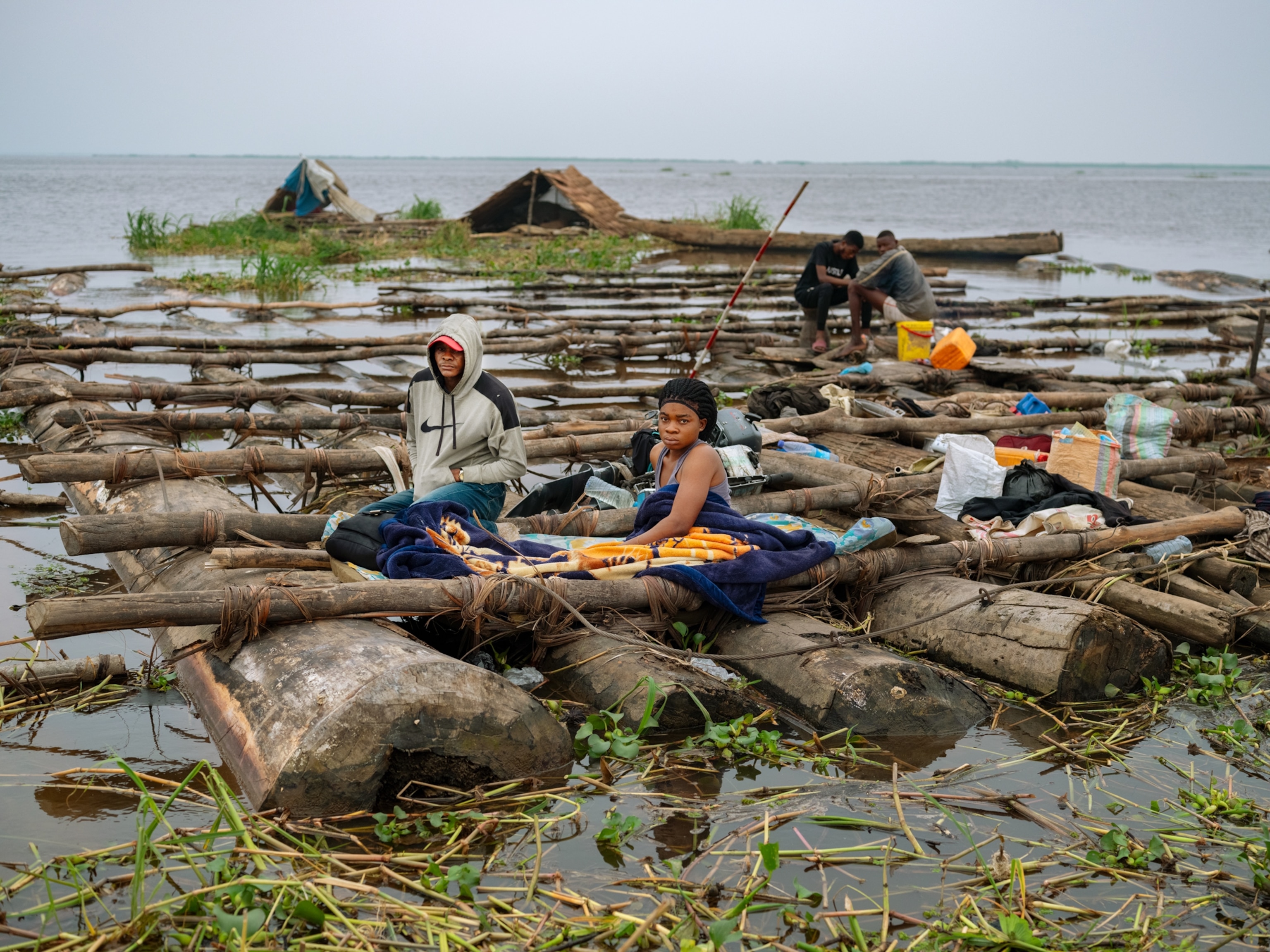
Timber sellers have lived for a month on this raft made of logs from the rainforest that they will sell at the port of Kinkole, outside of Kinshasa.
In the Yangambi station’s archives, head librarian Christian Besombi Afanta leads me to a corner behind rows of wooden bookcases filled with decades of scientific journals. The collection includes black-and-white photographs, several of which he spreads out across a large mid-century desk, pointing to images of beans and seeds at various stages of sprouting, along with close-ups of the different roots and leaves of many plants. “Belgians wanted to understand the structure of each existing species and determine its economic value,” he explains. This led to the rise of palm tree, rice, and coffee plantations, including the introduction of a still popular variety of robusta coffee bean.
Other photographs captured a darker side of the station’s story, showing Black men stuck laboring in the test fields while white scientists worked in laboratories. By the time Yangambi was built, the Belgian Congo had ended the Free State’s most monstrous practices, but the dynamics at the research station remained steeped in colonial exploitation. “Our grandfathers, our fathers were only workers here,” Afanta says. “They did almost everything manually, always under Belgians’ orders, regardless of the scale of the work. That’s how everything you see here, the infrastructure, was built by our ancestors. They were forced to do many things against their will for survival.”
By 1960, Congolese pro-independence leaders had rallied enough support to force Belgian authorities to grant the country independence and organize general elections. Belgian researchers left without having trained a single Congolese scientist to replace them. “The Belgians did not want to train anyone to be their equal. The goal was to subjugate,” Afanta says. “And so, after their departure, everything remained in a state of lethargy.”
But not everyone abandoned Yangambi.
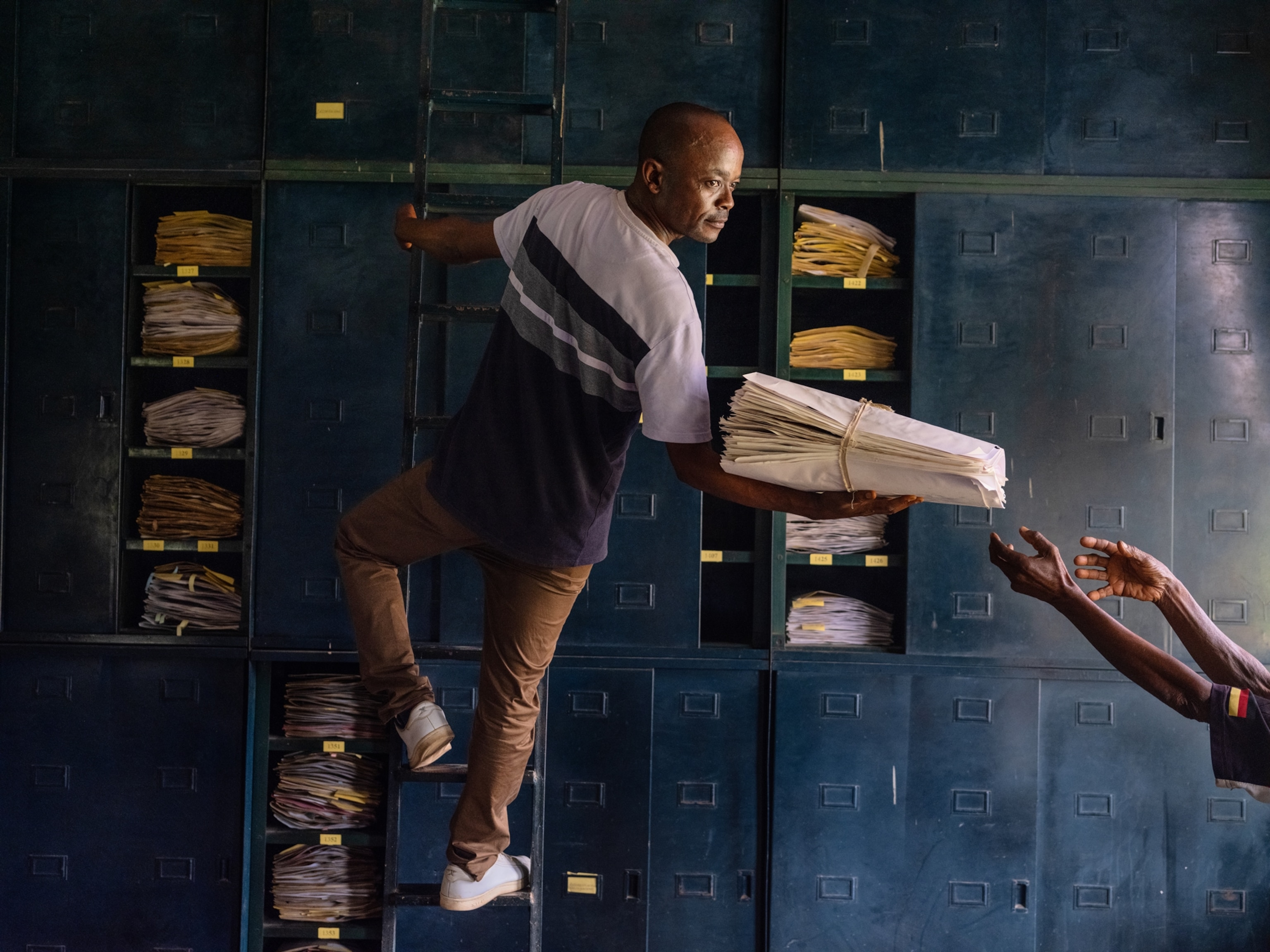
Archivist Fidèle Noa Manganga retrieves dried plant specimens at the National Herbarium at Yangambi, which houses 150,000 scientific samples.
At independence, the workers from surrounding villages recruited by Belgian scientists to perform small technical tasks kept quietly going about those tasks, even without the guarantee of payment from the newly formed Congolese state. And when they became too old to carry on, their sons took over, continuing the important duty of chronicling changes throughout the region.
Five times a day, observers like Henry Alangwi Angwale still do the work that has gone on for generations at the research station. One morning, I join him as he heads out to a grassy field a few miles away to meticulously record the meteorological data available from an assortment of rudimentary instruments that are arranged at intervals like a contemporary art installation. Using a pen and paper, he checks the readings on a pair of rain gauges (the same ones that were installed in 1928), thermometers, and a totalizing anemometer, which measures the speed and direction of the wind over time. “My father began working here decades ago. It was his life,” Angwale says. “But he was too tired.” So Angwale took over the job from his father, who passed away just six months after retiring.
In the meantime, the Congo Basin’s lack of reliable data on long-term climate change meant that the rainforest continued to be excluded or misrepresented in global reports and analysis. In 2021, it was one of only two regions worldwide without enough data for the United Nations Intergovernmental Panel on Climate Change to assess past trends in extreme heat—findings that other governments might use in determining what places deserved more resources for continuing study or even emergency aid.
(What’s behind the strange rash of ’dinosaur’ sightings in the Congo?)
More than 50 years after independence, the Yangambi station was still operating on a minimal budget with handwritten records stored in a decrepit office alongside stacks of yellowing paper bundles. Emmanuel Kasongo Yakusu, a forestry Ph.D. candidate at Ghent University in Belgium who teaches at the University of Kisangani, first learned in 2011 about the ongoing efforts of the station’s climate observers while seeking data that signal how communities dependent on the forest might face new challenges with climate change. “When I first walked in here, it was like walking into a gold mine,” he tells me, picking up a bundle dating back to the 1970s. So Yakusu began working with the department staff to digitize the records, focusing on temperature and rainfall.
The team was able to chart 60 years of data, tracking daily meteorological changes from 1960 to 2020 (save for 1965, when political unrest meant activities at the station ground to a halt). The collective findings, published in 2023, reveal a mean daily temperature increase of a third of a degree Fahrenheit (0.18 Celsius) per decade. The region has also seen a disruption of rainfall patterns toward drier dry seasons and shorter, more intense rainy seasons with fewer rainy days throughout the year. The temperature increases and changes in rainfall timing and intensity have become more pronounced since the turn of the 21st century.
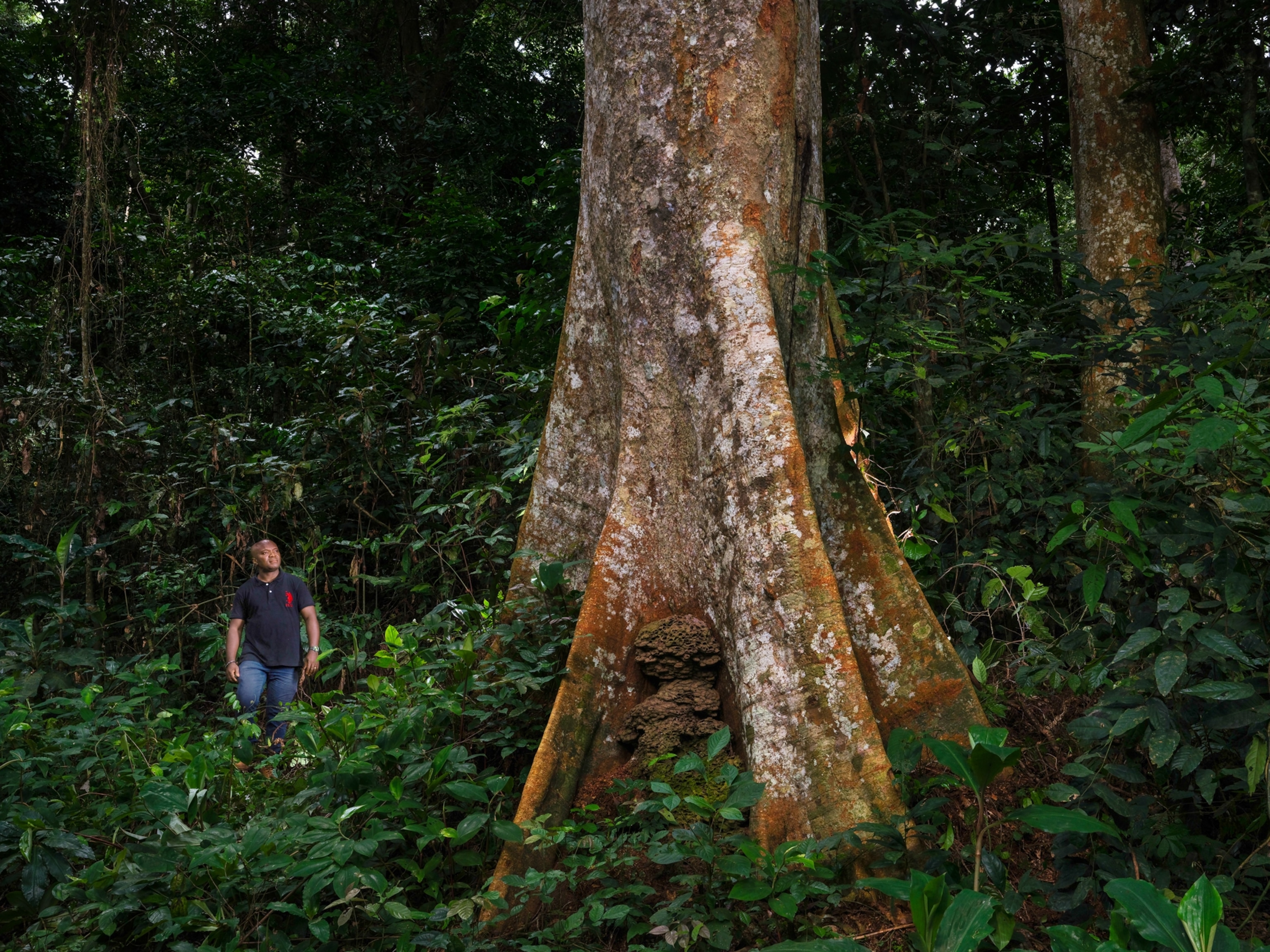
Climate scientist Emmanuel Kasongo Yakusu analyzed decades of Yangambi’s data and found rising temperatures and disrupted rainfall patterns—important not only to Central Africa but also to the world.
Today the staff at the center are fully trained and equipped with computers and a scanner to update the database independently. Their work with regional wind patterns influenced decisions on where the flux tower should be located and how it should be designed. José Mbifo Ndiapo, who directs climatology research at the station, remembers when Yakusu called to announce that their hard work was being formally recognized. “That day I got my staff together and told them, What you do here, never underestimate it. Do it right, as per our motto here at Climatology: Honesty, accuracy,” he says. “We felt valued.”
For Yakusu, Kimbesa, Ndiapo, and their peers, shaping the science is a crucial part of recovering from when the forest was harnessed for colonial gains. For them, the future of their communities is at stake; more than 60 percent of the DRC’s workforce are farmers. Hotter growing seasons with less regular rain means they can expect lower crop yields, while more weeds and pests proliferate.
“I grew up in Kisangani, and all my life I’ve seen how farmers struggle to make ends meet,” says Yakusu, who now also works as a consultant with the World Bank. Along with the Congolese government, the bank is developing the region’s first climate contingency plan, identifying potential emergencies and designing responses with the right kind of aid for local farmers.
While extreme weather events are becoming the norm in many places, most climate-impact research has focused on rich nations, leading to an “attribution gap,” as robust levels of data are lacking in low-income countries, which may leave people behind with little support to mitigate, prepare, and adapt. “With climate change, things are going to get worse,” says Yakusu. “They need urgent support. We need to create dynamic agricultural calendars and modernize farming techniques.”

The Yangambi station was abandoned in 1960 after Belgian rule ended, and parts of the complex fell into disrepair. Today this swimming pool has become a place to play football.
Yakusu and other Congolese scientists have been lobbying for international funds to create a network of weather stations in the DRC to gather accurate data across more land. “DRC has one of the lowest densities of weather stations in the world,” says Simon Lewis, a climate change and rainforest researcher at the University of Leeds in England, who supports the effort.
You May Also Like
Lewis led a team several years ago to map the extent of the Congo Basin peatlands. The team discovered that they are the largest tropical peatlands in the world, storing three years’ worth of global fossil fuel emissions. But, as Lewis recounts, his only advantage was to receive unrestricted funding to explore this “fuzzy” idea via a science prize. “The massive logistical and scientific efforts it demanded on the ground were only possible because of the deep local knowledge of our Congolese partners,” he says. “They knew about the peatlands and the potential for major discovery there, but the resources were not available to them.”
In 2023, Lewis joined a coalition of regional scientists to create the Congo Basin Science Initiative, a research group seeking $200 million in funding to green-light more homegrown studies—a move that has world-changing potential to transform our understanding of the rainforest. The effort, patterned after a similar successful program in the Amazon, has already attracted investment from the United Kingdom, including more graduate-level scholarships for researchers at partner institutions in Central Africa and the U.K. “Science is extractive in nature,” Lewis says. “We need to build equal partnerships and inclusivity between local and foreign scientists. Not just because it is right, but because it is the only way we can scale up the work that needs to be done before it’s too late.”
(Take a one-of-a-kind journey into the Amazon.)

Some in the Congo Basin are choosing more sustainable practices, like beekeeping, that work with the rainforest’s resources rather than deplete them.

Wooden huts shelter thermometers at Yangambi station where meteorological data have been collected since 1928.
Why the Congo Basin appears to be more resilient than the Amazon remains an incredibly complex question, and researchers are looking for answers in the trees. Back at Yangambi, Yakusu leads me down a trail through the surrounding forest and then signals that we should head deeper into the underbrush. As we leave the path, the texture of the ground suddenly changes, crackling softly as dried branches snap beneath our feet and then grow squishy as we step over the soft husk of a decomposing tree trunk. We finally stop in front of a huge tree with a wide, smooth trunk that juts high into the canopy. Part of the mahogany family of trees, it belongs to a particular native species called Entandrophragma utile.
The tree is part of another long-term survey that’s been happening at the station. To inspect it properly, Yakusu unslings his backpack and produces a wood borer shaped a bit like an oversize corkscrew, placing it against the trunk a few feet above the ground. When he turns the handle, the hardwood seems to resist at first, creaking under the pressure being applied. After a few minutes, Yakusu extracts a long, thin core sample of wood from the inner layers, which he carefully inserts into a protective sleeve. “You have to be careful to not let it break,” he says.
Inside the station’s modern wood biology lab—another first in the DRC—researchers would be able to compare the tree’s height and trunk diameter with visible rings from the core sample to determine changes in its growth over time in relation to the climate. “As we’ve demonstrated, the rainforest is warming,” Yakusu says. “This means that the environment in which these trees grow is changing and the conditions for growth are no longer optimal.” In the long run, decreased tree growth could lead to higher tree mortality in the region, one factor responsible for the Amazon’s diminishing capacity to store carbon.
Already some tree species are disappearing. In the research station’s archives, detailed records on a tree from the same genus, Entandrophragma palustre, show that it was once the most studied species at Yangambi. “But in this forest, you won’t find a single palustre today,” says Yakusu. At the same time, some trees are proving more resistant to extreme climate shifts, which could hold the key to helping the forest adapt. Chadrack Kafuti and Brice Djiofack, two tropical ecologists working at Yangambi’s wood lab, have been closely studying the adaptations of Pericopsis elata, a large-leaved hardwood with the surprising capacity to pause its growth during periods of drought or when sunlight is scarce. That kind of resilience could help direct replanting in areas where the forest has been logged for lumber or affected by wildfires, which are increasingly common.
(Our report on when the Congo Basin reopened to large-scale logging.)

Scientists are studying the rings of trees, such as this 800-year-old Entandrophragma utile at the Luki Biosphere Reserve in western DRC, to see how climate change has affected their growth and to build a historical climate record for the region.
Without strong environmental protections, the Congo Basin is projected to lose 27 percent of its undisturbed rainforests by 2050. But these Central African scientists work with the knowledge that the rainforest has never been untouched landscape. It is a place that has been and will be continually reshaped by human habitation. Exploring the outcome of such interactions may lead to other surprises. For instance, Nestor Luambua, a forest ecologist who manages Yangambi’s wood lab, is studying whether some human-made disturbances, such as clearing for villages and slash-and-burn agriculture, may partly explain why the Congo Basin is still absorbing relatively high amounts of carbon today. Over time, those clearings have given way to new growth, encouraging trees like Pericopsis elata.
Before we leave the survey site, Yakusu retrieves the borer and fills the hole in the tree with leaves to prevent insects from crawling inside and causing damage. He pats the trunk gently as though saying goodbye to an old friend.
Each of the scientists at Yangambi has developed a soft spot for a particular species of tree, often the one each has been studying over the years. For Fabrice Kimbesa, that special plant is the Combretum lokele, a somewhat gnarled tree that does not grow any higher than about 20 feet here, making it sometimes difficult to spot from his perch atop the flux tower. “It could keep going, but instead, it will break and give birth to many small trees on the same trunk,” he tells me at one point. “It’s sharing and caring for others. What could be more beautiful?”
(Can a new way to measure tropical rainforest vulnerability help save them?)
A version of this story appears in the April 2025 issue of National Geographic magazine.
Mélanie Gouby is an investigative journalist and filmmaker based in London. She has spent more than a decade working in Africa on stories that explore conflict, inequality, and environmental issues.
Award-winning photographer Nichole Sobecki is based in Nairobi and chronicles how climate change is reshaping our planet and humanity’s connections to it.
The nonprofit National Geographic Society, committed to illuminating and protecting the wonder of our world, funded Explorers Mélanie Gouby and Nichole Sobecki’s work. Learn more about the Society’s support of Explorers.


